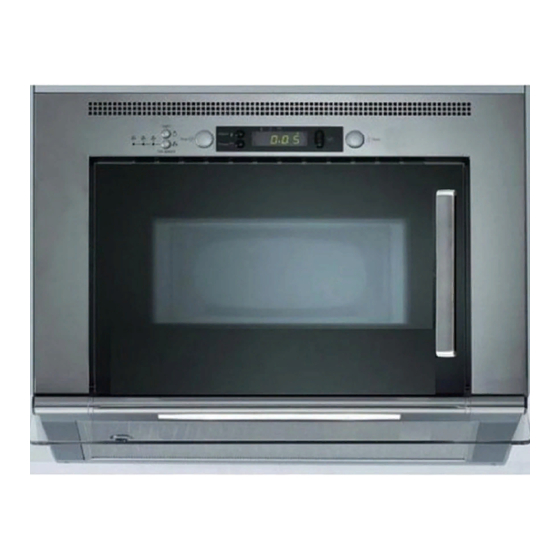Whirlpool YUMV4084 Kullanım ve Bakım Kılavuzu - Sayfa 7
Havalandırma Davlumbazı Whirlpool YUMV4084 için çevrimiçi göz atın veya pdf Kullanım ve Bakım Kılavuzu indirin. Whirlpool YUMV4084 28 sayfaları. Microwave hood combination
Ayrıca Whirlpool YUMV4084 için: Kurulum Talimatları Kılavuzu (24 sayfalar), Kullanım ve Bakım Kılavuzu (15 sayfalar)

To Change Settings:
1. Press and hold Jet Defrost control for about 3 seconds, until
"Cset" appears in the display.
2. Press the +/- control to select language, then press Start
control.
3. Press the +/- control to select weight entry mode, then press
Start control to complete the setting. Depending on the
language setting, "Done" or "Fini" will appear in the display.
Vent Fan
The vent (exhaust) fan has 3 speeds: high, medium and low. The
fan speed indicator lights show the current fan speed. If left on,
the fan will automatically shut off after 4 hours.
Override Mode
To keep the microwave oven from overheating, the vent fan will
automatically turn on at high speed if the temperature from the
range or cooktop below the microwave oven gets too hot. It may
stay on for several minutes to cool the microwave oven. When
this occurs, the vent fan cannot be turned off and the fan speed
cannot be changed until the temperature drops below a certain
level.
A magnetron in the microwave oven produces microwaves which
reflect off the metal floor, walls and ceiling and pass through the
turntable and appropriate cookware to the food. Microwaves are
attracted to and absorbed by fat, sugar and water molecules in
the food, causing them to move, producing friction and heat
which cooks the food.
To avoid damage to the microwave oven, do not lean on or
allow children to swing on the microwave oven door.
To avoid damage to the microwave oven, do not operate
microwave oven when it is empty.
Baby bottles and baby food jars should not be heated in
microwave oven.
Clothes, flowers, fruit, herbs, wood, gourds, paper, including
brown paper bags and newspaper, should not be dried in
microwave oven.
Paraffin wax will not melt in the microwave oven because it
does not absorb microwaves.
Use oven mitts or pot holders when removing containers from
microwave oven.
Do not overcook potatoes. At the end of the recommended
cook time, potatoes should be slightly firm. Let potatoes
stand for 5 minutes. They will finish cooking while standing.
Do not cook or reheat whole eggs inside the shell. Steam
buildup in whole eggs may cause them to burst, requiring
significant cleanup of microwave oven cavity. Cover poached
eggs and allow a standing time.
Food Characteristics
When microwave cooking, the amount, size and shape, starting
temperature, composition and density of the food affect cooking
results.
Amount of Food
The more food heated at once, the longer the cook time needed.
Check for doneness and add small increments of time if
necessary.
MICROWAVE OVEN USE
NOTE: While the fan is in override mode, the fan speed indicator
lights will not necessarily reflect the actual speed (high).
To Turn Vent Fan On/Off: Press Vent Fan control repeatedly to
scroll through the speeds or to turn off.
Cooktop Light
To Turn Light On/Off: Press Light control repeatedly to toggle on
and off.
Tones are audible signals that cannot be turned off, and they
indicate the following:
Two tones
Reminder, repeat every 30 seconds
Three tones
End of cycle
Size and Shape
Smaller pieces of food will cook more quickly than larger pieces,
and uniformly shaped foods cook more evenly than irregularly
shaped food.
Starting Temperature
Room temperature foods will heat faster than refrigerated foods,
and refrigerated foods will heat faster than frozen foods.
Composition and Density
Foods high in fat and sugar will reach a higher temperature, and
will heat faster than other foods. Heavy, dense foods, such as
meat and potatoes, require a longer cook time than the same size
of a light, porous food, such as cake.
Cooking Guidelines
Covering
Covering food helps retain moisture, shorten cook time and
reduce spattering. Use the lid supplied with cookware. If a lid is
not available, wax paper, paper towels or plastic wrap approved
for microwave ovens may be used. Plastic wrap should be turned
back at one corner to provide an opening to vent steam.
Condensation on the door and cavity surfaces is normal during
heavy cooking.
Stirring and Turning
Stirring and turning redistribute heat evenly to avoid overcooking
the outer edges of food. Stir from outside to center. If possible,
turn food over from bottom to top.
Arranging
If heating irregularly shaped or different sized foods, arrange the
thinner parts and smaller sized items toward the center. If
cooking several items of the same size and shape, place them in
a ring pattern, leaving the center of the ring empty.
Piercing
Before heating, use a fork or small knife to pierce or prick foods
that have a skin or membrane, such as potatoes, egg yolks,
chicken livers, hot dogs, and sausage. Prick in several places to
allow steam to vent.
Tones
7
